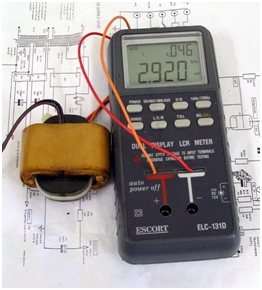Next part of our memeber’s tutorial on measuring instrumements…
LCR meter is another very useful measuring device that is extensively used by electrical engineers and companies manufacturing related products. So first f all I will start with the basic conventional introduction of this measuring instrument followed by its working.
An LCR meter is used to measure the inductance, Capacitance and resistance of the device under test. We know that the inductance is denoted by L, capacitance by C and resistance by R. So it is just so clearly visible that why this device is known as a LCR meter in short for convenience.
The useful of the devices is just evident from the fact that it acts as a three in one measuring instrument, which can measure for you all your three required values just in one package.
Working of an LCR meter
The next question that will definitely be arising in your mind is that how does it work? How does it cope with the operation of all the three devices in just one small package? Well the answer is really simple, i.e. the working of an LCR meter is pretty straightforward and nothing complex.
To make it simpler for you, I have explained this working in 5 easy steps below:
- Firstly an alternating voltage is passed through the device under test (also known as DUT)
- The meter than measures the voltage through this device. As we know that a voltmeter is connected in parallel in the circuit for measuring the voltage. So the connections of the LCR meter are also such that it measures the voltage from across the DUT.
- Next the meter measures the current passing through the DUT. This is measures such that I is in series. This all happens in the internal circuitry of the device and the user does not have to change the connections again and again.
- By taking the ratio of both its measurements, the LCR meter calculates the inductance (L) of the DUT.
- Afterwards the capacitance and the resistance of the device under test are calculated according to the value of the impedance measured from the device and are displayed as shown below:
- We assume that the LR elements of the inductor resistor coil are in series and the CR elements of the capacitance resistance coils are in parallel.
Advantages of an LCR meter
- One thing that is evident is that it is compact and a three in one sort of a measuring unit which is obviously preferable.
- Other than this it is also worth mentioning here that an LCR meter is quite accurate and gives the readings with a high precision.
- It can also tell about the angle between the voltage and the current measure if needed.
- It is easy to calibrate and quick to use, the user just needs to connect the two probes of the meter to the DUT as shown below:
Applications of an LCR meter
LCR meters are being widely used in electrical related industries now-a-days for measuring these ratings of different devices. For example they are used to measure the inductance, capacitance and resistance of different newly manufactured appliances like refrigerators, televisions etc.
They are also used in laboratories for circuit testing and components calibration. In short they are of wide usage in daily life.
So this was all about LCR meters. To know more such stuff about measuring devices keep visiting us. And, of course, you still can giv eyour impressions on the comments section below!



Nice LCR info piece! I would add too that there are a wide range of LCR meters available, from units costing less than $20 on eBay to models costing many thousands of dollars. While it’s tempting to purchase a very inexpensive meter, quite often you get what you pay for. A cheap LCR meter might be fine for a hobbyist, but for measurements that you really must count on in R&D, production, and service, get an LCR meter from a major manufacturer.
I use the HM8118 (from Rohde & Schwarz) It has a basic accuracy of 0.05%, and in addition to measuring the resistance, inductance and capacitance of passive components, it measures the nonideal characteristics of real components, such as series equivalent resistance (Rs) and parallel equivalent resistance, (Rp) of capacitors and inductors (very important). It also calculates derived parameters, such as the quality factor Q, the dissipation factor D, the phase angle Theta, as well as the complex values of the impedance Z and the admittance Y.
Rich, thanks for the comment.
So from the value Cp measured on the meter, how can we extract the actual capacitance assuming we know the area and thickness